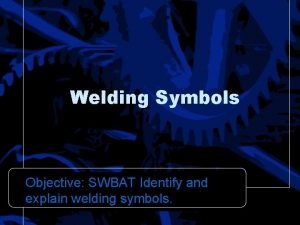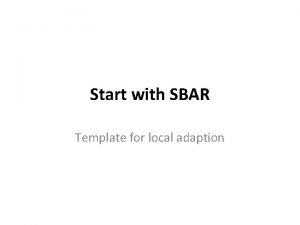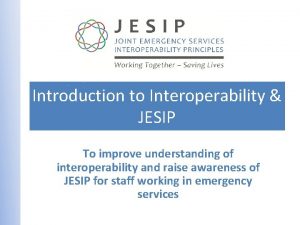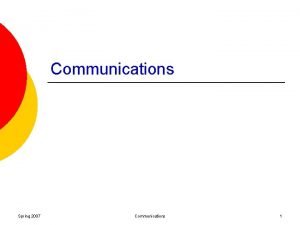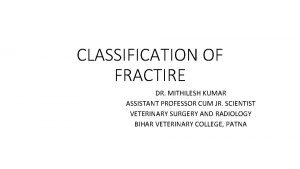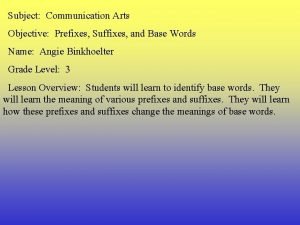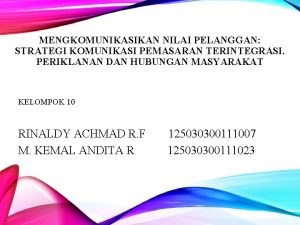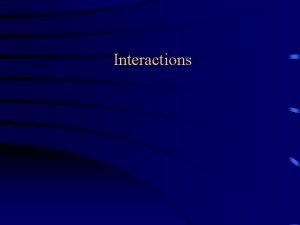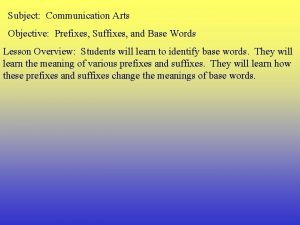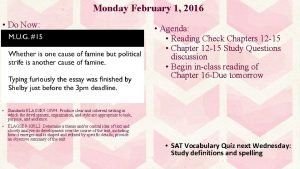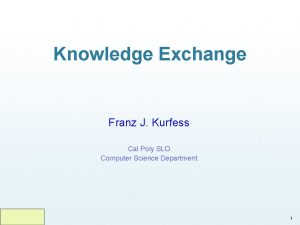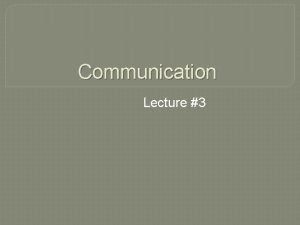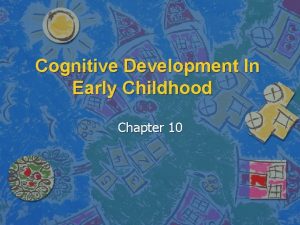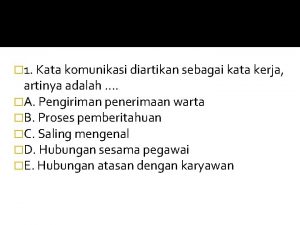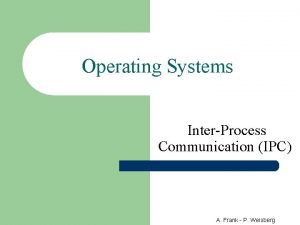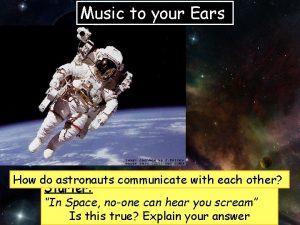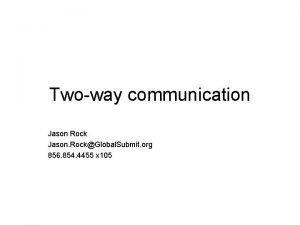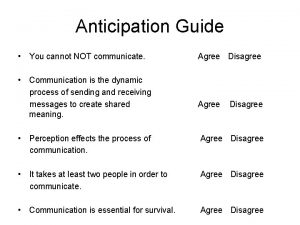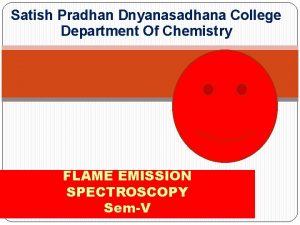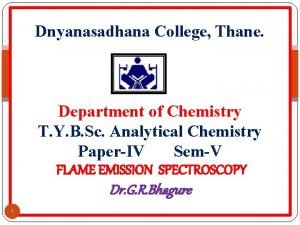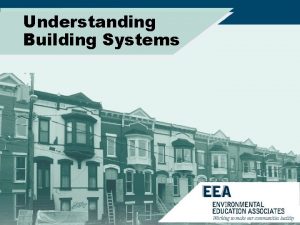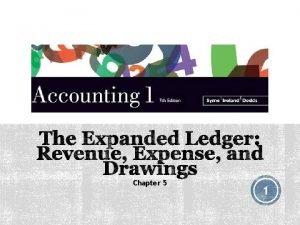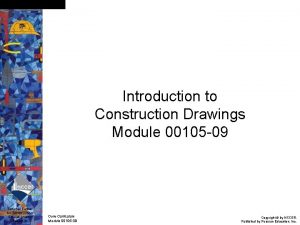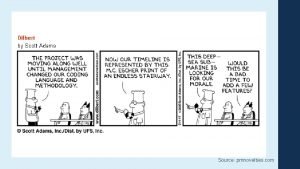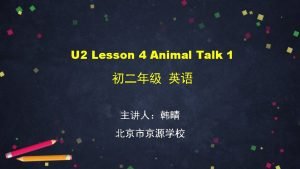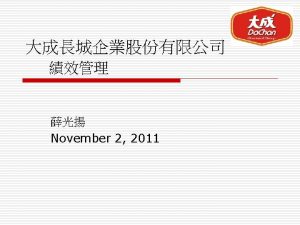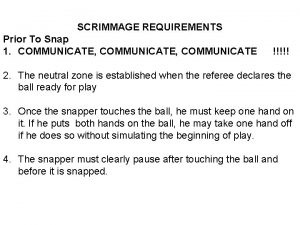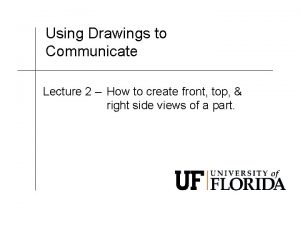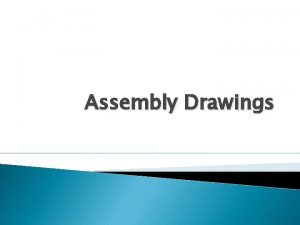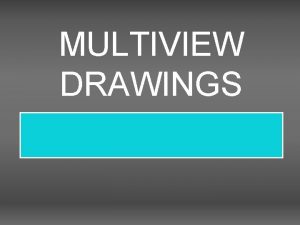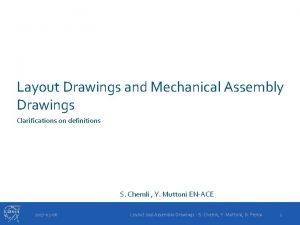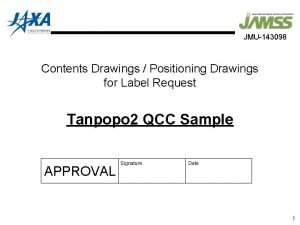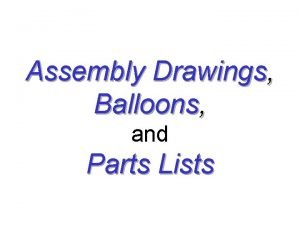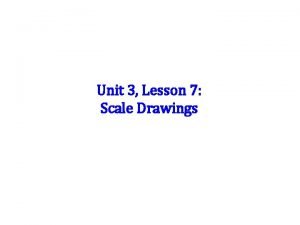Drawings Review Drawings Drawings are used to communicate














































- Slides: 46

Drawings Review

Drawings • Drawings are used to communicate information – Sketch: • A drawing done without instruments or measurements, but conveys the general idea and proportions – Technical Drawing: • Serves as a reference and presences all information is drawn with tools and is to scale

Drawings – Technical Drawings (cont) • Geometric Layout: – Set of lines that form a technical drawing • Basic Lines: – the standard graphic symbols that form a technical drawing (allow it to be a reference document)

Drawings – Technical Drawings (cont) • Dimensioning – The inclusion on a technical drawing of the dimension required to manufacture (create) an object » Use dimension lines and extension lines • Tolerance – The imprecision allowed between a part’s actual dimensions and the corresponding dimensions that appear on a technical drawing

Drawings • Scale: – The relationship between an object’s dimensions in a drawing and the actual dimensions of the object » Full-size scale or actual-size scale » Reduction scale: drawing is smaller than real life » Enlargement scale: drawing is bigger than real life


Projections • Projections: – a 3 D representation of an object in 2 D • Types of Projections: – Orthogonal Projections: • Multiview (Orthographic) - Top, Front, Right view • Isometric – Oblique projections

Projections • Projections (cont) – Exploded view – Cross-section: • Drawing of an object as if it were cut by a cutting plane line

Projections • Projections (cont) – Sections • Partial representation of an object that presents only the object’s surface on the cutting plane • Types of section: – Revolved – Removed

Projections • A) Definition: – A projection is a representation of a 3 dimensional object in two dimensions – Uses Basic Lines • B) Types of projections – 1. Orthogonal Projections • Multiview • Isometric – 3. Oblique Projections

Multiview Projection

Isometric Projection

Oblique Projection

B) Types of Projections • A) Multiview Projection: – Definition: • A 2 dimension representation of different views (faces) of an object (usually front, top and right side) – Advantages: • Provides a complete description of the object • Allows for the representation of all the measurements to scale or as is

Multiview Top View Front view Right side view


B) Types of Projections • B) Isometric Projection: – Definition: • A drawing depicting all 3 dimensions of an object • The axis (x, y, z) are at 120 degree angles of each other.

Isometric • The edge of your shape is facing the page • You can see all three angles without distortions

B) Types of Projections • 2. Oblique Projections – Definition: • A drawing depicting all 3 dimensions of an object where one side is parallel to the paper – This distorts the depth of the object


* Please Note • For construction purposes: – Use a combination of multiview and isometric projections as they show the overall design – For a more detailed drawing showing all the parts, we have an exploded view

** Exploded view • Purpose: – Projection accompanying the assembly instructions or specifications of an object – Made up of different parts which are drawn separately from one another • Exploded views include: – The names of each part (the nomenclature), the quantity and bill of materials (material list)

1. Diagrams • 3. Standards in diagrams – Symbols for Force • Compression • Tension • Shearing – Symbols for movement • Translational • Rotational • Helical

1. Diagrams • 3. Standards in diagrams – Symbols for parts • Screw/bolt • Nut – Symbols for guides • Translational • Rotational

Motion Transmission Systems

Motion Transmission • A) Definition: • A motion transmission system transmits the same type of motion from one part of an object to another • For example: rotational to rotational

Specific system vocabulary – Motion transmission systems contain: – A driver: a component that initiates the motion – At least a driven component: that receive the motion and transfers it – Some systems might also contain intermediate components between the driver and driven components Driven Driver Intermediate

Specific system vocabulary • Reversibility: – A system is considered “reversible” when the driven component could become the driver unit, and it would not change any of the motion types

Motion Transmission B) Types of motion transmission systems 1. 2. 3. 4. 5. Gear Train Chain and Sprocket Worm and Screw gear Friction Gears Belt and pulley

Motion Transmission 1. Gear trains • Contains at least two gears that meet and mesh together Direction of Alternates from components one gear to another Reversibility Yes

Motion Transmission When building a gear train, you must consider: 1. The Gear teeth (they must be evenly spaced, the same size and have the same direction) 2. The Gear types (straight gears vs. bevel gears) 3. The Gear size (the higher the number of teeth, the slower the rotation) The larger the diameter the slower the rotation

Motion Transmission 2. Chain and sprocket • Connects components that are far away from one another. • The gears do not mesh together; they are connected with a chain (or sprocket) Direction of components The sprockets inside the sprocket will turn in the same direction. Reversibility Yes

Motion Transmission When building a chain and sprocket, you must consider that: 1. The teeth on the sprocket are identical 2. The chain links must mesh easily with the sprocket’s teeth 3. The system requires constant lubrification 4. The smaller the sprocket the fastest it turns

Motion Transmission 3. Worm and screw gear – Consists of one endless screw and at least a gear – It is not reversible When building a worm and screw gear, you must ensure that: 1. 2. The gear teeth match the worm’s grooves The driver must be the worm

Motion Transmission 4. Friction gear systems – Similar to gear trains yet less efficient because the friction gears can slip. – The larger the gear the slower the rotation

Motion Transmission 5. Belt and pulley system – When building a belt and pulley system, you must ensure: 1. Pulleys must contain a groove where the belt can fit 2. The belt must adhere to the pulleys 3. The smaller the pulley the faster it turns

Speed Change In Motion Transmission Systems

Speed Change 1. Worm and screw gear • For each turn of the worm, the gear moves by one tooth. The greater the number of teeth the slower the speed.

Speed Change 2. Remaining systems • The speed varies with the number of teeth (or the diameter of the gears) – If motion is transmitted to a smaller gear, the speed is increased – If motion is transmitted to a larger gear, speed is decreased – If motion is transmitted to a gear of equal size, there is no speed change

Motion Transformation systems

Motion Transformation A) Definition • Relaying a motion from one part to another while altering the nature of the motion (e. g. rotation to translation or translation to rotation) B) Types of motion Transformation systems 1. 2. 3. 4. Rack and pinion Screw Gear systems Cam and follower Slider–Crank mechanism

Motion Transformation • 1. Rack and Pinion – Contains a rack (straight bar with teeth) and a pinion (gear) While building a rack and pinion you must ensure that: 1. The teeth on the rack and on the pinion must be identical 2. The system requires frequent lubrification 3. The greater the number of teeth on the pinion the slower the rotation

Motion Transformation • 2. Screw gear systems (2 Types) – Contains a screw and a nut – Type 1: the screw is the driver • Transforms rotational motion into translational motion (e. g. jack to lift the car) – Type 2: the nut is the driver • Transforms translational motion into rotational motion

Motion Transformation 3) into Cam and Follower – Rotational motion changed translation motion When building a cam and follower, you must ensure that: 1. The follower must be guided in its translational motion 2. The shape of the cam determines how the follower will move 3. A device such as a return spring is usually necessary to keep the follower in continual contact with the cam.

Motion Transformation • Eccentric vs. Regular cam – In a regular cam, the axis of rotation is centered. – In an eccentric cam the axis of rotation is off-centered. – – –

Motion Transmission • 4. Slider-crank mechanism – This is the mechanisms used in pistons
 Insidan region jh
Insidan region jh Iso weld symbols
Iso weld symbols Sophisticated printer used to produce high-quality drawings
Sophisticated printer used to produce high-quality drawings Feedback is a technology that sends resistance
Feedback is a technology that sends resistance How do people communicate
How do people communicate Persuade inform entertain pie
Persuade inform entertain pie Sbar template
Sbar template Jesip
Jesip How do people communicate
How do people communicate Site:slidetodoc.com
Site:slidetodoc.com Channel richness
Channel richness Communication skills definition
Communication skills definition Nici unu
Nici unu Spiral fractire
Spiral fractire Effective communication
Effective communication Communicate prefix and suffix
Communicate prefix and suffix Communicating value
Communicating value Communication is contextual
Communication is contextual Object can communicate with each other through
Object can communicate with each other through Prefix and suffix for communicate
Prefix and suffix for communicate New system communicate let us know
New system communicate let us know Explain how scouts treatment of the roly poly
Explain how scouts treatment of the roly poly Russell norvig
Russell norvig Persons in lpscs careers must effectively communicate with
Persons in lpscs careers must effectively communicate with How do processes communicate
How do processes communicate When we communicate verbally we should use
When we communicate verbally we should use Talking aloud to oneself with no intent to communicate
Talking aloud to oneself with no intent to communicate Kata komunikasi diartikan sebagai kata kerja artinya …
Kata komunikasi diartikan sebagai kata kerja artinya … Examples of ipc systems
Examples of ipc systems Youtube.com
Youtube.com How neurons communicate
How neurons communicate Why communicate
Why communicate Globalsubmit communicate
Globalsubmit communicate You can not not communicate
You can not not communicate Communicate information fairly and objectively
Communicate information fairly and objectively Chapter review motion part a vocabulary review answer key
Chapter review motion part a vocabulary review answer key Ap gov final review
Ap gov final review Nader amin-salehi
Nader amin-salehi Prisma diagram example
Prisma diagram example Narrative review vs systematic review
Narrative review vs systematic review In a premix burner used in fes the fuel used is
In a premix burner used in fes the fuel used is In a premix burner used in fes the fuel used is
In a premix burner used in fes the fuel used is Enlarged drawings show components larger than their
Enlarged drawings show components larger than their Picture of a warm front
Picture of a warm front Plumbing drawings
Plumbing drawings Drawing is dr or cr
Drawing is dr or cr Module 00105
Module 00105

